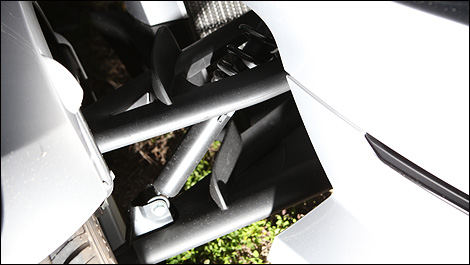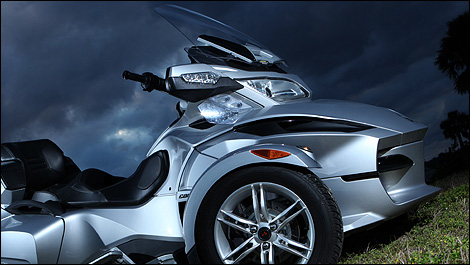Stability Control with roll (leaning) mitigation
This is new grounds for two- and three-wheelers, with only the Spyder and BMW’s S1000RR sportbike using lean and-or lateral acceleration sensors to help manage the engine. When the rider reaches a set cornering limit, the system cuts power and applies the brake on the outside front wheel, to slow things down safely.
 |
| The right front suspension, with automobile style A-arms and co-axial shock-spring combination, with preload adjustement but no damping adjustment. (Photo: Philippe Champoux/Auto123.com) |
We noticed that moving our butt to the inside of the corner and thus reducing lean for a given speed, seemed to allow the machine to corner a little harder before the system kick in and slows things down.
Throttle-by-wire
Throttle position and changes are transmitted electronically to the ECU, which then manages injection timing and fuel quantities, as well as ignition timing and throttle butterfly openings to optimise operations, be it power, economy or emissions. This smart throttle technology is becoming increasingly popular on cars and bikes, as it also allows the system to smooth out the delivery of torque, which does not always pour out smoothly from an engine, but rather with flats and bumps as revs build up. This last torque-smoothing functions adds to the smoothness of the engine and effective rear wheel traction, much goodness on slippery roads.
Dynamic Power Steering
Driving a Spyder without power steering would be a great muscle builder for shoulders and arm, but too often beyond the capabilities of more mature or lighter users when parking, changing direction or just keeping it on the straight and narrow for hours on end.
This is where an intelligent power assist comes in, providing extra assistance at slow speeds and when stopped, and gradually reducing the assist level as speed builds, to allow for more feel from the road to come through.
 |
| This side view shows how the air is directed around the driver, and helps create a channel to extract hot air from the radiator so it avoids the driver and passenger. You can also find a hint of negative wing to create downforce at speed and help stability. (Photo: Philippe Champoux/Auto123.com) |

